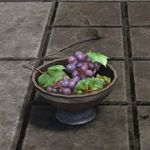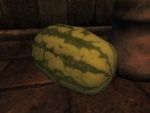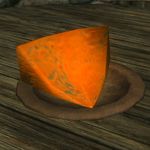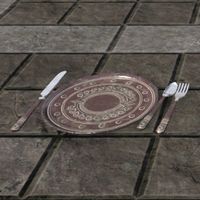Imperial cooks approach food the same way they face the rest of life: in a straightforward and proud manner. As shrewd diplomats and traders, they stock their larders with many of the best ingredients Tamriel has to offer. Cyrodiil's central location in Tamriel, paired with its wealth and power, assures that the Imperials eat well from a variety of meats, vegetables, and spices from across the continent.[1]:11 There are many culinary texts written about Imperial cuisine of particular regions such as the Niben Watershed.[2]
A high class Imperial feast will typically follow a set selection of courses. The first course may consist of introductory savories meant to enliven the palate while the second may consist of fish based dishes. As is custom the fish course is followed by a course of vegetables. Up next is a course of grain based dishes, this is typically the last course in less wealthy households who don't readily have access to meat and poultry. Otherwise, the fifth course will consist of game and poultry which is then followed by the main meat course. Finally, the penultimate course is made up of desserts and the feast is ended with a final course of digestifs such as cheeses and nuts.[3]
| Name |
Description |
Image |
| Colovian War Tortes |
A torte originating from the Colovian Highlands.[15] |
|
| Date and Berry Cake |
This dish is served with a frosting of sugared cheese. The cheese is woven in intricate and beautiful knots upon the cake's surface.[10] |
|
| Fireberry Tartlets |
Fireberry tartlets are tarts that are folded in such a way that they can be held and eaten without fear of leakage or soiled garments.[10] |
|
| Honeycomb |
(?) |
 |
| Nord Milk |
Despite the name, this dish has nothing to do with Nords. Rather, chefs induce milk into a frozen, semi-solid state that is among the most delightful confections one can enjoy. However, it is only available to the extremely privileged given the expense that goes into creating it.[10] |
|
| Roasted Beehives |
Entire beehives filled with honey may be served with cinnamon after being gently roasted in an oven.[10] |
|
| Stewed Plums |
This dish is served with cream. The plums may be replaced with other fruits.[10] |
|
| Sweetcake |
A type of cake that is commonly eaten across Cyrodiil.[16] |
|
| Yogurt |
Yogurt made of goat's milk is known to be eaten in the West Weald. |
|
| Name |
Description |
Image |
| Almfingers |
This dish uses ovens of Akaviri design to puff saltrice grains to several times their size, which gives them a peculiar honeycomb-like texture. Honey mixed with mustard is placed in a bowl, allowing the diner to coat their hands in the sticky sauce, then in puffed saltrice. The puffed saltrice and sauce are then licked off the hand.[4] |
|
| Apples |
Apples are commonly grown and eaten by Imperials.[17] |
|
| Beet Risotto |
A dish of rice cooked in stock, in Bravil it is made with a beet stock.[18] |
|
| Blackberry |
Blackberries are grown by Imperial farmers. They also grow wild in the West Weald.[19] |
|
| Corn |
Imperial farmers grow corn as a crop. It is eaten on the cob with seasonings.[20] It is also baked into bread[21] or made into a corn and millet chowder.[22] |
|
| Cyrodiil Citrus |
Cyrodiil Citruses are tangy, thick-skinned oranges that have been a staple of Cyrodilic cuisine since time out of memory. The toughness and long shelf life make them a perfect addition to Imperial Legion rations.[23] |
 |
| Eyes of Mara |
Eyes of Mara are balls of seasoned rice filled with a grape must. They are normally a confection for children.[4] |
|
| Garlic Carrots |
In Nibenay, carrots are often served seasoned with garlic.[24] |
|
| Garlic Radishes |
In the city of Kvatch, radishes seasoned with garlic are a common dish.[25] |
|
| Grapes |
Grapes are found growing in abundance in the region of Skingrad and are used in wine production and eaten on their own. |
 |
| Ground Nuts |
Ground nuts are served as a digestif after a meal.[10] |
|
| Imperial Mushroom Sauce |
This mushroom sauce has its origins in the outlying regions from which the auxiliary soldiers of the Imperial Legion are drawn, what was once a simple country dish has become a favorite staple on the tables of even Imperial Legion generals.[1]:37 |
|
| Kelp Fritters |
Kelp fritters are made from tough kelp harvested from the islands of the Topal Bay. The kelp is steeped in tea for days to soften the leathery texture, then dredged in flour and then folded in the manner learned from bookmakers. It is then dipped in beaten egg and covered in breadcrumbs before being dipped in lard. The result is a complex assortment of textures. A crisp outer coating, chewy middle layers, and creamy inner ones. They are served with an aioli made of truffle oil.[4] |
|
| Leeks |
Leeks are used as an ingredient in soups.[6] |
|
| Melon Salad |
A fruit salad made from melons, in Bravil it is seasoned with garlic.[26] |
|
| Niben Braids |
Noodles prized for their length with some being over nine feet long. May be served in a sauce of stewed herbs.[4] |
|
| Onions |
Onions are eaten and used in meals across Cyrodiil. |
 |
| Pears |
Pears are eaten across Cyrodiil.[27] |
|
|
| Pumpkin Fritters |
Fried snacks made with pumpkin. In Cyrodiil they are also made with millet grain.[28] |
|
| Red Almonds |
Red Almonds are seen as a sign of good fortune. These nuts, which must pass through the digestive tract of certain badgers, are slow to mature in flavor and thus difficult to acquire.[10] |
|
| Strawberries |
Strawberries are grown by Imperial farmers. They also grow wild in the West Weald.[29] |
|
| Stuffed Banana Leaves |
Banana leaves are sometimes served with a filling of millet grain and various greens.[30] |
|
| Truffles |
Truffles are known to be eaten and made into oil. |
|
| Umber Persimmons |
This sweet fruit is often eaten on its own. The pith of the fruit can be pounded flat with a mallet and lightly brushed with garlic oil.[4] |
|
| Watermelon |
Watermelons are grown and eaten across Cyrodiil. |
 |
| Name |
Description |
Image |
| Bats |
Bats are frequently eaten across Blackwood's marshes. For many local fisherfolk, they represent an abundant source of meat when fishing is poor. Netted bats are skewered and roasted whole while being basted in a yogurt sauce and topped with chopped nuts.[31] |
|
| Beaver Tails |
Beaver Tails are rolled in flour and fried.[5] |
|
| Clams |
Clams are known to be eaten in Leyawiin. |
|
| Crabs |
Crab meat from Mudcrabs is commonly eaten across Cyrodiil. |
|
| Cured Eggs |
Chicken eggs are buried and cured in clay for months before being roasted in salt coals. Certain techniques can be used to turn these eggs into large egg puffs, a satisfying and aromatic dish.[5] |
|
| Dolphin Calf |
Dolphin calf simmered in the milk of its mother is an Imperial perversion of a popular Nord feast, which similarly simmers a calf in the milk of a mare, though it is done with cattle, not dolphin. The richness of this dish cannot be overstated, as both the flesh of dolphin and the milk they produce are denser than any creature of the land.[5] |
|
| Dormice |
Known to be eaten by Imperial nobles, where the dormice are fattened on a diet of goose fat to the point that, when eaten, even the bones of these creatures dissolves on the tongue.[31] |
|
| Jellied Beaks |
Beaks softened in brine before being made into an aspic and served with a cream sauce.[31] |
|
| Jugged Animals |
Jugging is when an animal has been left to stew for a period of time in a jug or other container, either in its own blood or other ingredients, often a combination of both. In Bruma, rabbits are commonly used for this cooking technique.[32] |
|
| Loaf of Tongue |
This is primarily a noble dish that is assembled from the tongues of whatever creatures suit the household, for example, duck tongues. It is served with a green sauce of mint and chervil.[5] |
|
| Lobsters |
Lobsters are eaten in a variety of ways, such as in stews or on their own as a meal. |
|
| Marrow and Tendons |
This dish is a favorite of the Imperial nobility. It fuses the culinary traditions of Imperial cuisine with Akaviri influence, particularly in the seasoning and preparation of the tendons, which are dipped in ox bones as implements for scooping marrow.[31] |
|
| Milt |
Milt from live mudcrabs is eaten by Imperials. While roe-laden female crabs are suitable for a pauper's table, nobles preferred to sup on the rich and milky milt of male crabs.[5] |
|
| Mudcrab Fries |
Potato fries made with mudcrab meat. On the Gold Coast of Cyrodiil this dish is served with melon.[33] |
|
| Niben Pike Stuffed with Creamed Sorrel |
This dish is a classic example of Niben river cuisine. Stuffing a fish with sorrel and other herbs is a common method of preparation. At his infamous feast, Emperor Brazollus served this dish with a twist: the pike was baked in a saffron crust.[5] |
|
| Octopus |
Octopus is eaten on its own and in pies by Imperials in Blackwood. |
|
| Oysters |
Oysters are served alive in their shell and shucked tableside. In traditional Niben fashion, diners use garnishes of olive brine in addition to a wine reduction fortified with minced onion.[5] |
|
| Rats |
Rats are known to be eaten by Imperials.[34] There was an attempt to create a rat-themed menu in the Cyrodilic city of Leyawiin. The restaurant was quickly shut down by the local guards, and its owner was forcibly expelled from the settlement, dishes they were known to serve include:
- Deep-Fried Rat[35]
- Lemon Rat and Wild Rice[35]
- Rat Flambe[35]
- Rat Necrom with Bonemeal Gravy[35]
- Rat Ragu with Powdered Deer Penis[35]
- Rats in a Cream Sauce[35]
|
|
| Reman's Pottage |
A pottage made from the eyes of ducks.[31] |
|
| Roast Boar |
Boar meat prepared by roasting.[36] |
|
| Roasted Camel |
Roasted camel may be found at Imperial feasts. One extravagant method of preparation involves stuffing the whole camel with lamb, stuffing the lamb with chickens, then the chickens with eggs, with the eggs coated in nuts and having the whole dish spiced with cinnamon.[31] |
|
| Roast Turkey |
The meat of a large bird which is roasted before serving. In Colovia it is cooked alongside tomatoes and millet.[37] |
|
| Saints |
One historical practice among the Imperials involved the disinterring of Imperial saints who's skeletal remains where then ground and used as an ingredient. However, this practice of "saint-eating" was banned in the late First Era.[4] |
|
| Senche Heart Fillets |
The heart of a senche cut into fillets, often served with sugar cane. It is described as being tender when prepared.[31] |
|
| Shepherd's Pie |
This dish is eaten across Cyrodiil. |
|
| Slaughterfish Pie |
A flour crusted pie with a filling consisting of slaughterfish meat and various greens.[38] |
|
| Squid |
Squid is known to be eaten as a meal and in stews in Leyawiin. |
|
| Stuffed Piglet |
A young swine filled with a stuffing of grapes and radish before serving.[39] |
| Stuffed Swan |
A dish served at grand feasts that is stuffed with a variety of fillings.[31] |
|
| Topal Garnetbeak |
Topal Garnetbeak was a common feature of noble tables. Most often, these creatures were drowned in fortified wine. They were plucked immediately before serving, and diners ate these creatures whole, typically with cloths draped over their heads. Ostensibly this was to trap the vapors of the wine, but in truth, it was to contain the viscera and juices that often violently ejected from the bird as it was eaten. Years of this practice have left the Topal garnetbeaks extinct.[5] |
|
| Name |
Description |
Image |
| Amber Ale |
An ale not uncommon in Colovia, it is brewed from wheat and enjoyed mixed with metheglin.[40] |
|
| Battlehorn Wine |
The vineyards of the Battlehorn region, in the Highlands close to the Hammerfell border, produce some of the finest hearty reds to found in Cyrodiil. Boisterous and full-bodied, the practice of aging wine in oak barrels provides subtle flavors to the finished product that has been served at the tables of numerous noble households for generations.[41] |
|
| Beer |
Beer is made with fermented grains. It is very common in Cyrodiil, where it is produced by fermenting starch. |
 |
| Bitter Barley Beer |
Originating in Bravil, this barley beer is flavored with bittergreen and ginger.[42] |
|
| Black Marsh Peach Wine |
[43] |
|
| Colovian Brandy |
An expensive Imperial brandy made in Colovia. |
 |
| Cyrodilic Brandy |
An expensive, but invigorating and stimulating alcoholic beverage with few unpleasant side effects. It is made in Cyrodiil and exported across Tamriel. |
 |
| Fifth Legion Porter |
Named for one of the Imperial Legions, This wheat beer is flavored with rose and ginseng.[44] |
|
| Flin |
An expensive and stimulating Cyrodilic whiskey popular in Morrowind. It has few unpleasant side effects. The flin trade is profitable and managed by the East Empire Company.[45] |
 |
| Ginger Beer |
Imperials brew a yeasty ginger beer, popular in Colovia.[46] |
|
| Great Ambrosia |
A white wine produced in the Niben Forest, among the sweetest and most fruity of all Imperial wines.[43] |
|
| Grenache |
A red wine. Imperials in Kvatch have a unique spin on the style, blending it with coffee and seaweed for an energizing beverage. [47] |
|
| Imperial Stout |
Named for the race that brews it, this stout beer is made from barley and guarana which is then blended with metheglin.[48] |
|
| Kvass |
An alcoholic beverage made from fermented rye bread. Imperials make a red kvass flavored with rose and acai berry.[49] |
|
| Mead |
Mead (also called Nord Mead, or Honey Wine by the Altmer) is an alcoholic beverage made from fermented honey and water, alternatively with molasses, and sometimes strained with mashed grains. It is a very popular drink that can be found primarily in the province of Skyrim, but it can also be seen across the continent of Tamriel, as brewing is the basis of any culture. Mead is very popular among the Nords of Solstheim, who usually import it from mainland Skyrim. Meaderies across the provinces have their own ingredients and recipes, mixing in their own spices and fruits like Juniper Berries.
|
|
| Milk |
|
|
| Mint Chai |
Chai tea brewed from mint leaves. Imperials sometimes add acai berries to a cup as well.[50] |
|
| Mulled Wine |
Popular with Imperial Legionaries stationed in Skyrim, this drink was invented when an enterprising garrison cook in the region sought to whip up a hot drink to ward off the cold. It is made by heating up wine, herbs, spices, and cinnamon in a pot.[1]:167 |
|
| Muscat |
A style of red grape wine common in Skingrad where it is also made with comberries.[51] |
|
| Nerianth Fine |
A type of Colovian red wine produced in the hills west of the Niben River, close by the dry plains of Anequina.[43] |
|
| Petite Gray |
A white wine produced in the Niben Forest, among the sweetest and most fruity of all Imperial wines.[43] |
|
| Queen's Tear |
A type of Colovian red wine produced in the hills west of the Niben River, close by the dry plains of Anequina.[43] |
|
| Shadowbanish Wine |
Shadowbanish Wine is a notoriously rare collection of wine that was made for the Imperial Legion throughout Cyrodiil. The magic imbued in the wine gifted the drinkers with night eye, for late-night surveillance on cold nights.[52] In 2E 582, the Shadowbanish Vintners was a group active in the Interregnum who held wine-tasting parties in Trader's Cove.[53] In 3E 433, a wine collector from Weye tasked an adventurer to find the last of the wine in the various ruins throughout Cyrodiil. These locations span across the province, from Fort Grief to Fort Vlastarus. Eventually, six bottles of Shadowbanish Wine were recovered and added to the collection.[54] |
|
| Sherry |
A style of white wine. A type produced in Cheydinhal is made with honey.[55] |
|
| Skingrad Wine |
Skingrad wines benefit from the introduction of lavender, lotus, cornberries, and ginger to their vineyards, adding new dimensions to the grapes grown there.[41] |
|
| West Weald Wallop |
Wallop is a blended wine made of less successful harvests and small, marginal vintages. It is notable for its high sugar and alcohol content, hence its name. Other wine-producing regions have their own versions, but few can compare to even the least successful harvest from West Weald. It makes an excellent table wine and is often served mulled, as a port, or distilled into a very passable brandy.[41] |
|
| White Moon |
A white wine produced in the Niben Forest, among the sweetest and most fruity of all Imperial wines.[43] |
|
Imperial artists produce ivory spice shakers in stylized shapes of Imperial Knights.[56]















































